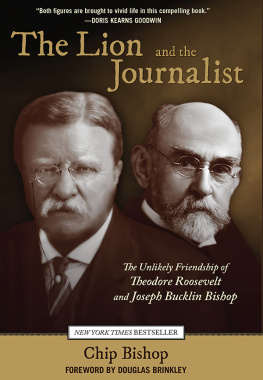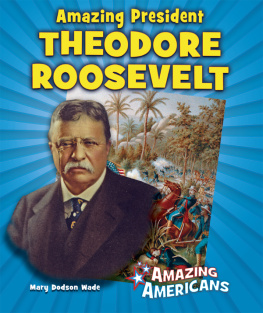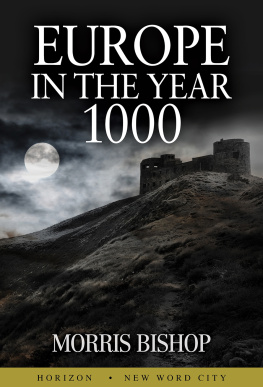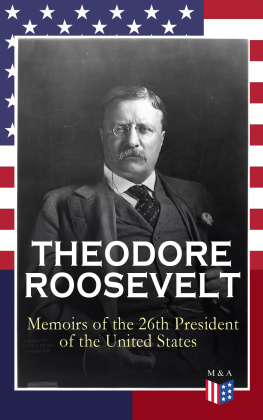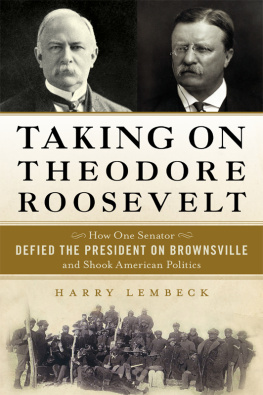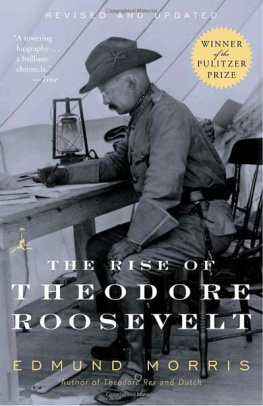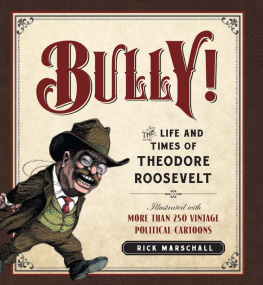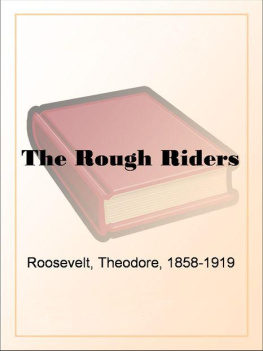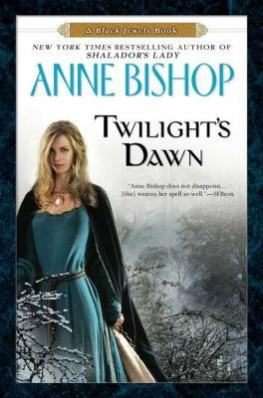The Lion and the
Journalist
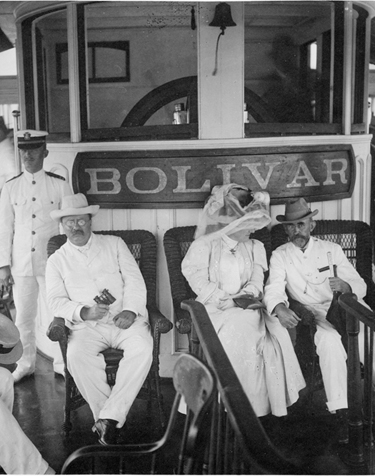
Theodore Roosevelt, Edith Roosevelt, and Joseph Bucklin Bishop aboard the Balboa in Cristbal Harbor, Panama, November 17, 1906.
The Lion and the
Journalist
The Unlikely Friendship of Theodore Roosevelt
and Joseph Bucklin Bishop
Chip Bishop
FOREWORD BY DOUGLAS BRINKLEY

For Jane Louise,
beloved and friend
Copyright 2012 by Chip Bishop
Foreword copyright 2012 by Douglas Brinkley
All rights reserved. No part of this book may be reproduced or transmitted in any form by any means, electronic or mechanical, including photocopying and recording, or by any information storage and retrieval system, except as may be expressly permitted in writing from the publisher. Requests for permission should be addressed to Globe Pequot Press, Attn: Rights and Permissions Department, P.O. Box 480, Guilford, CT 06437.
Lyons Press is an imprint of Globe Pequot Press.
Frontispiece courtesy of Anita and Miriam Bishop collection
Text design: Sheryl Kober
Layout artist: Melissa Evarts
Project Editor: Ellen Urban
Library of Congress Cataloging-in-Publication Data is available on file.
E-ISBN 978-0-7627-8302-1
Foreword
Everything Theodore Roosevelt did throughout his life was duty- bound, including the wise self-selection of Joseph Bucklin Bishop as his official biographer. While Bishop wrote numerous books and scores of magazine articles unrelated to our twenty-sixth president, he is best remembered in history for editing Theodore Roosevelts Letters to His Children. A newspaper editor from 1870 to 1905, Bishop was always defending Roosevelt against bad operators in the private sector and government. He was a combination press agent, defense counselor, and let-your-guard-down loyalist. At Roosevelts request, Bishop left the newspaper world in 1905 to become executive secretary of the Isthmian Canal Commission in Washington, D.C., and Panama. The important post came about because of Bishops unflinching editorial support of the 1903 Panamanian Revolution, followed by the construction of the Panama Canal, linking the Atlantic to the Pacific. His book, The Panama Gateway, remains mandatory reading for anybody even vaguely interested in Latin American history.
It wasnt just political compatibility that led Roosevelt to choose Bishop as his Boswell, though. As is clearly evident from the hundreds of letters T. R. sent to Bishop between 1897 and 1918, their friendship, that mysterious cement of the soul, came naturally to the two Atlantic seaboard intellectuals. No matter what the societal circumstances, Roosevelt and Bishop pulled for each others daily action. They had a symbiotic friendship, one that developed at the end of the nineteenth century in New York. Roosevelt was New York City police commissioner when they first met, and Bishop was an editor of the New York Evening Post . Both reformers fearlessly waged war on Tammany Hall.
Every good statesman needs a top-tier journalist he can trust, and Bishop played that role with Roosevelt. There were times when T. R. didnt correspond with Bishopthe hard-charging weeks in Spanish-ruled Cuba, his yearlong naturalist collection trip for the Smithsonian Institute in British East Africa, his near-death encounter traversing Brazils Rio da Dvida. But for the most part, Roosevelt used Bishop as his sounding board on issues ranging from the 1902 Anthracite Coal Strike to the political strategy for the 1908 presidential election to the launching of the Bull Moose Party in 1912.
But it was in the drama surrounding the Panama Canal intrigue that made Bishop one of the indispensable figures in Roosevelts White House. Dispatched to Panama, traveling around the countryside in the tropical heat of the teeming jungle, Bishop took prodigious notes for Roosevelts perusal back in Washington, D.C. In a very real sense, Bishop served as Roosevelts probing eyes and ears in Panama for seven full years, well after T. R. had left the presidency. Because the Panama Canal was Roosevelts pet project, he regarded Bishops memos as crucial dispatches, always anxiously awaiting their arrival by mail.
Loyalty, its been said, is the most treasured quality any U.S. president can have; its always in short supply. As Chip Bishop makes clear in The Lion and the Journalist a pioneering, smartly rendered biographythe friendship between the president and the reporter was reciprocal in nature. Each man was a confidant of the other. Bishop served as a kind of media watchdog for T. R. throughout his public career, making sure he didnt get blindsided by some print assassin. Bishop, for his part, truly enjoyed the privileges accorded to a trusted counselor. Together they helped stabilize the progressive movement with their sober-minded critiques of modern America. Your editorials, Roosevelt once wrote Bishop, are a real comfort to me.
Not that the friendship was on an entirely equal footing. Sometimes Roosevelts impetuousness ventured into the dictatorial. Take the 4:25 train, T. R. ordered Bishop in one missive. But Roosevelt so entirely valued Bishops companionship that he would frequently invite him and his wife, Harriet, to dinner at the White House and at his Oyster Bay home, Sagamore Hill. Although Roosevelt was an optimist, he genuinely enjoyed listening to Bishops skinny about various scoundrels of the day. Of Bishops counsel, Roosevelt wrote, I am always wishing I could see you.
Late in life, plagued by a series of health maladies, Roosevelt entrusted Bishop with the publication of private letters to his six children. The book Theodore Roosevelts Letters to His Children , published in 1919, just after Roosevelts death, and a runaway hithumanized the president much more than T. R.s An Autobiography . It was only Bishopno one elseto whom T. R. would have entrusted the editing of this deeply intimate and emotional correspondence with his beloved brood.
Legacy meant a great deal to Roosevelt, as it does to all U.S. presidents. Bishop was the man T. R. thought most suited to write his authorized biography. Bishop proved to be an inspired choice. Drawing on thousands of candid and illuminating letters that Roosevelt wrote to friends and associates, many marked personal , others clearly written to shed new light on his presidential thinking and decision-making in a turbulent era of progressivism and global expansionism, Bishop produced a two-volume masterwork. Theodore Roosevelt and His Time Shown in His Own Letters, published in 1920, has become essential biographical reading.
Now Chip Bishopthe great-grandnephew of Joseph Bucklin Bishophas seized the historical reins himself. Using the T. R.Bishop correspondence and an array of wonderful anecdotal events as his literary foundation, our Bishop has written a groundbreaking study of the great symbiotic friendship between the colonel and his editor. It will be impossible to write on T. R. again without first reading this marvelous book.
Douglas Brinkley
Introduction
Wheels on the Earth
The old lion is dead, Archie Roosevelt wired his siblings from Sagamore Hill on January 6, 1919. His father, the redoubtable Rough Rider and twenty-sixth president of the United States, had died gently in the middle of the night. In his bedroom at the family estate on a great hill in Oyster Bay, New York, Theodore Roosevelt went quietly to the ages, an act uncharacteristic of someone who otherwise had yielded to few men or forces in his sixty tumultuous years.
Next page
